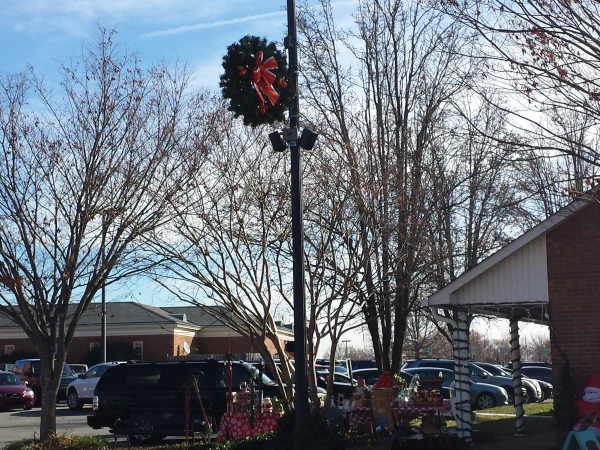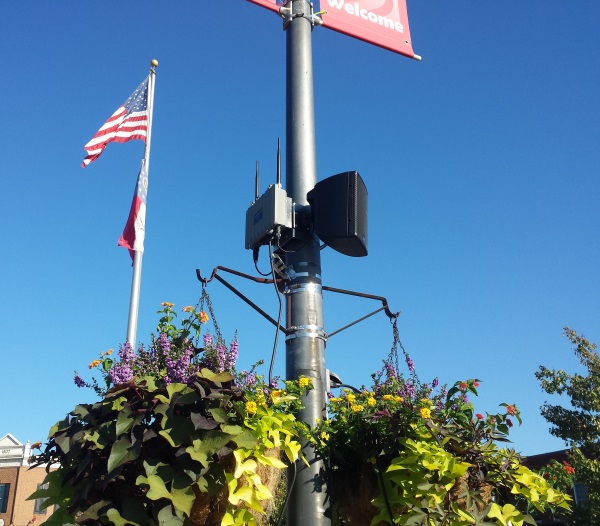Frequently Asked Questions
Q. How do we install the StreetSounds® remote units?
A. The StreetSounds® STS-70-205 includes a stainless steel mounting bracket
that is designed to be installed on a 4” to 6” pole with two metal bands (hose clamps).
If an AC power plug is available on the streetlight pole, all you need to do is
attach the STS-70-205 to the pole with two metal bands (i.e. Ideal Tridon Pow’r
Gear 6X) and plug in the AC power cord. That’s it! The system has been designed
so that most Public Works personnel can easily install the system with minimal equipment
or cost.
Below is a video which shows the complete installation of a StreetSounds® unit.
Q. What is the transmission range of the radio?
A. The average radio range is between 600’ and 800’ with standard antennas, limited obstructions, and no interference. However, the typical placement of StreetSounds® units is 120’ to 150’ apart on the average city block. The more important consideration is the range, or coverage, of the sound. This will normally dictate where the StreetSounds® units are mounted. With 2 speakers aimed in opposite directions along the block, a typical placement of 120' is usually adequate for a low to moderate "background" sound level. Traffic noise will also have an effect on distance between units. The tradeoff will be playing music at a low level, yet having adequate audio coverage for the desired area.
Q. Can I add more StreetSounds® units if I want to expand my coverage area?
A. Yes, you can add as many StreetSounds® radios any time you like. Each StreetSounds® radio is a “repeater” so it will re-transmit the radio signal to units that are further away. This way, you can start with just a few StreetSounds® units and add more as budget becomes available. The only “range” that really matters is the distance between two adjacent StreetSounds® units.
Q. How many StreetSounds® units will I need for my 2-block downtown Main Street area?
A. We typically estimate that the units should range from 120’ to 150’ apart to provide good sound coverage. Since most city blocks in smaller towns are about 350’ in length, you would need ~two to three StreetSounds® unit per block . If you want sound coverage on both sides of the street, you could either “zig-zag” the installations, or install additional units on the other side of the street. If your streets are narrow with little traffic noise, the zig-zag approach works well. If your streets are wide with significant traffic noise, units should be placed on both sides of the street.

Q. Do the StreetSounds® systems require AC power?
A. Yes. The STS-70-205 requires either 110VAC or 220VAC. This power is generally available on a typical streetlight pole. Some streetlight poles already have AC outlets which significantly simplifies the installation of the StreetSounds® unit. If an AC outlet is not already present on your streetlight pole, you will need to have one installed by a qualified electrician. The average power required is typically less than 10 watts when music is being played at a background level, but will not exceed 100 watts maximum.
Q. What kind of audio can I send on the StreetSounds® system?
A. StreetSounds® is a “real-time” streaming stereo audio system that produces very high quality audio (pro-audio) transmissions. “Real time” means that the system acts like a “PA” (public address) system and sends audio with less than 35msec of delay from one location to the next. This is very different from other systems in which the audio is sent via Wi-Fi as a “file” (i.e. mp3, AAC, WMA) and then played when someone hits the “Play” button. StreetSounds® is like having your own local radio station.

Q. Does StreetSounds® transmit on Wi-Fi (or Bluetooth, or ZigBee)?
A. No. StreetSounds® uses the 900 MHz unlicensed frequency band which is much less crowded than 2.4 GHz or 5 GHz Wi-Fi bands. Signals at 900 MHz travel much further than 2.4GHz or 5GHz and can penetrate “obstructions” such as trees, people, and buildings much better that the higher frequencies. Also, AirNetix has developed a proprietary radio transmission protocol that is designed SPECIFICALLY for high-quality, real-time audio transmission. In fact, the predecessor to StreetSounds®, the ARX-900 AiRocks Pro, uses this same wireless audio transmission technique and has been serving the (very picky) pro-audio market for the past two years. The system is very robust and does not depend on Wi-Fi to carry the signal. Wi-Fi is not well suited to carrying real-time audio signals especially during periods of network congestion. Bluetooth is better suited for audio, but cannot “broadcast” or “relay” the signal like StreetSounds®. ZigBee is a “best effort”, packet-oriented system like Wi-Fi and is not well-suited to real-time transmissions.
Q. Are the StreetSounds® products weatherproof?
A. Yes. The STS-70 radio is fully weatherproof and is housed in an aluminum enclosure that is IP65 rated. The speakers supplied with the STS-70-205 are also fully weatherproof and include an IP54 rating. Both are designed for permanent outdoor installation.
Q. Can I move the StreetSounds® unit after installation if I don’t like the sound coverage?
A. Yes. StreetSounds® are very flexible and can be moved to change or improve sound coverage after initial installation. You could install the system in one configuration for a while, then change locations of units if you like. The system is very flexible.
Q. Is there Master transmitter?
A. Yes. A StreetSounds® “network” consists of at least one “Master” transmitter and one or more “Remote” or “Relay” units. The Master can be located anywhere within radio range of a StreetSounds® unit. As long as the Master can reach at least one StreetSounds® location, the signal will be relayed to each of the other Remote units. Since each StreetSounds® radio is a “repeater” the signal will be sent from one pole to the next, creating an almost unlimited range of radio coverage. You can even go around corners of the block to reach business areas that are not located on the Main Street.
Q. Can I move the Master transmitter?
A. Yes. You can use the Master at its normal location (i.e. in a street-side office) during a typical business day, and then move the Master to a different location if there is an event, such as a parade or festival. For example, if there is a festival with a band, you could temporarily move the Master to the stage and send the band’s music (at much lower audio levels!) all along the street. This could also be used as a temporary “announce” location for “lost and found” or emergency communications such as “lost child” or “emergency vehicle” announcements. Some customers buy two Master units, mount one permanently on the side of a building, and use the other as a "mobile Master" for outdoor events.
Q. Is the StreetSounds® system Stereo?
A. Yes. StreetSounds® has two audio channels that can be used to send a stereo audio signal. However, the two audio channels don’t necessarily have to be used for a stereo audio. You could use the two channels for completely different audio content (i.e. music + paging).
Q. How much audio power can the StreetSounds® system provide?
A. StreetSounds® includes a two-channel audio amplifier that is capable of providing 35 watts RMS per channel (x2) into an 8 ohm speaker, producing 70 watts RMS into two 8 ohm speakers. A total of 100 watts RMS is available if you use 4 ohms speakers or multiple parallel 8 ohm speakers. However, 70 watts of power provides a surprisingly loud sound when units are placed at 120' intervals.
Q. Can I use different speakers on the StreetSounds® unit?
A. Yes. StreetSounds® is capable of driving any 8 ohm or 4 ohm speaker. You could even use StreetSounds® to drive “landscape” or buried speakers. Care should be taking to properly wire series and parallel connections of speakers. Consult AirNetix with any concerns or questions.
Q. Can I monitor and control the Remote StreetSounds® units?
A. Yes. The StreetSounds® system includes a comprehensive Network Management System (NMS) that runs on a standard Windows PC. The NMS gives the operator full visibility and control over each remote unit in the network. You can see, in real time, if the remote unit is working properly. You can also control the volume at each remote from the NMS screen.
Q. Can the StreetSounds® remotes units be turned on and off automatically?
A. Yes. The StreetSounds® system includes a "Scheduler" that lets you control up to six "zones" or groups of radios automatically based on time of day and day of week. The Scheduler will turn on or off zones at any time you choose during any day of the week.
Q. Is there an Alarm monitor in the StreetSounds® system.?
A. Yes. StreetSounds® includes an Alarm monitor system that keeps an eye on several critical functions and sends the operator a text and/or email message if something isn't working correctly.
Q. What about theft?
A. Theft will always be a valid concern with any outdoor-mounted equipment. A mounting height if 12 feet or greater is recommended to move the unit from the "temptation zone".
